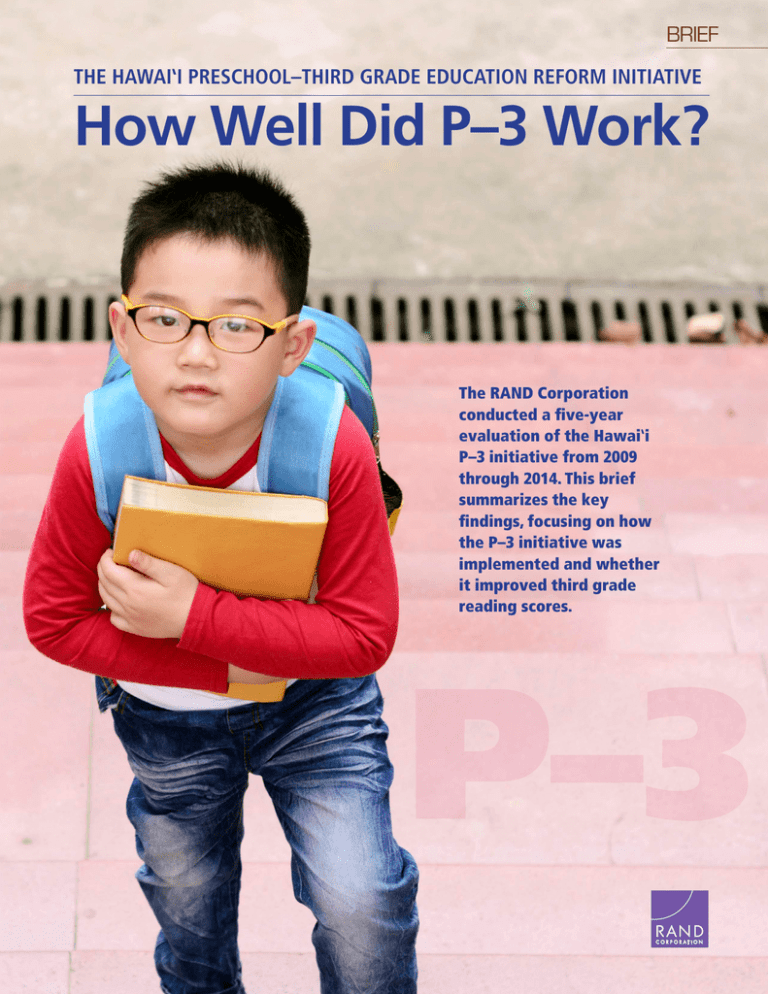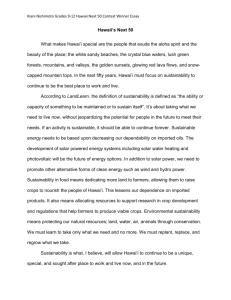How Well Did P–3 Work? BRIEF
advertisement

BRIEF THE HAWAI‘I PRESCHOOL–THIRD GRADE EDUCATION REFORM INITIATIVE How Well Did P–3 Work? The RAND Corporation conducted a five-year evaluation of the Hawai‘i P–3 initiative from 2009 through 2014. This brief summarizes the key findings, focusing on how the P–3 initiative was implemented and whether it improved third grade reading scores. P–3 C O R P O R AT I O N A range of evidence suggests that public schools are failing to prepare students for success in work and life. Several education reforms have emerged over the past decade to address these concerns. The “preschool through third grade” or “P–3” education reform movement aims to improve students’ kindergarten readiness and sustain high-quality early education experiences through elementary school. Proponents of P–3 note that many students enter kindergarten lacking the basic skills needed to succeed in school and that those who enter kindergarten with such deficits tend to stay behind. They also note that many early education gains fade out after children enter elementary school. With support from the W. K. Kellogg Foundation, the Hawai‘i P–20 Partnerships for Education—a collaborative overseen by state leaders in early, K–12, and higher education— launched the state’s P–3 initiative in 2007, one of the first comprehensive P–3 initiatives. The initiative’s goal was for every child in Hawai‘i to read at grade level by third grade. Five demonstration sites were selected to implement the initiative in their communities, and P–20 also implemented state-level work. Areas of Focus Working jointly with preschool and K–3 leaders, the demonstration sites were expected to conduct activities with these aims • A lign P–3 curricula • Implement preschool and K–3 teacher assessments • P rovide professional development to teachers and administrators • Improve access to early learning services • W ork with schools and parents to increase the number of children with preschool experience and ease their transitions to kindergarten • S upport parents as their children’s first teachers • B uilding professional capacity in the P–3 workforce • R aising awareness of the potential value of early learning among policy leaders • E stablishing state guidelines for early learning objectives and family involvement • L inking preschool and K–20 data in a longitudinal database books: SchulteProductions/iStock; child reading: liangpv/iStock State-level work focused on these areas How Effective Was Initiative Implementation? Through interviews and document reviews we determined that the state-level and demonstration site work included core P–3 features, that most of the elements of system change had been implemented, and that the work will contribute to long-term change in Hawai‘i’s P–3 landscape. Lacking, however, is planning for future work. State-level efforts are likely to yield lasting system change because they have been institutionalized in new standards and programs. Demonstration site efforts, more dependent on the support of local leaders with uncertain tenure, may be less likely to endure. Did the P–3 Initiative Improve Third Grade Reading Scores? This is the first P–3 evaluation to analyze whether P–3 reforms produced improvements in third grade performance by analyzing reading score data—in this case, data drawn from the Hawai‘i State Assessment (HSA) reading assessment. Specifically, we compared the scores of students in the five sites with those of students in schools not exposed to P–3. The analyses included all 192 elementary schools with available test score data for seven years—spring 2008 to spring 2014—for a total of 98,909 students. Our evaluation finds evidence that more years of participating in the P–3 initiative raised student reading scores modestly but significantly and increased the likelihood of scoring proficient on the state reading test. The P–3 initiative targeted low-performing schools in the state; thus, relative to other schools, demonstration site (P–3) schools started with a sizable reading proficiency gap (see figure below). In 2008, 64 percent of students in schools that were not part of the P–3 initiative were proficient in reading, while 53 percent of students who were eventually part of the initiative were proficient, an 11 percentage point gap. By 2014, that gap had narrowed to 7 percentage points—67 percent versus 60 percent. Viewed another way, over the seven-year period covered by the data, the gap in scores between schools that never participated in P–3 and those that did narrowed by four points on the HSA reading score. This impact is comparable to estimates of the effects of nine additional weeks of schooling and is higher than an estimate of the average effect size for elementary school interventions for mainstream students. Although activities other than P–3 were occurring in the sites that may have contributed to these impacts, the findings are encouraging in showing a narrowing of the reading score test gap by the end of the P–3 initiative. In seven years, the reading gap narrowed by four points. 64% NON-P–3 SCHOOLS 67% 7-point gap 2008 11-point gap 53% 2014 60% P–3 SCHOOLS The impact of Hawai‘i P–3 Initiative on reading scores, shown here by percentage proficiency as measured on the Hawai‘i State Assessment. What Are the Future Implications for P–3 Initiatives and Evaluations? Determine in advance an appropriate balance between standardization and sitespecific needs and resources, rather than relying on one-size-fits-all approaches. Consider contracts that specify outcomes rather than activities—increasingly recognized as a valuable approach for education and social service contracting. Establish measurable, standardized outcomes for the work to make monitoring possible and suggest mid-course corrections if the work is not producing expected outcomes. Plan explicitly for unanticipated changes in policy and personnel. Consider sustainability from inception. Require explicit agreements between high-level early education and K–12 administrators to engage in collaborative work to support strong coalition-building. A mother reads to her daughter at a Hawai‘i P–3 initiative preschool site. What We Learned The Hawai‘i P–3 initiative sites implemented work commonly understood to be at the core of a preschool through third grade (P–3) reform approach, executed most activities outlined in their plans, and implemented most elements required to effectively promote system change. More years of participating in the P–3 initiative raised student reading scores modestly but significantly and increased the likelihood of scoring proficient on the state reading test. This impact is comparable to estimates of the effects of nine additional weeks of schooling and is higher than an estimate of the average effect size for elementary school interventions for mainstream students. Little systematic effort was made to plan for a next phase of the P–3 initiative or identify funding to continue the activities. RESEARCH REPORT Final Report on the Hawai‘i P-3 Evaluation Gail L. Zellman and M. Rebecca Kilburn Sponsored by the Research Corporation of University of Hawai‘i C O R P O R AT I O N This brief describes work done in RAND Labor and Population and RAND Education and documented in Final Report on the Hawai‘i P–3 Evaluation, by Gail L. Zellman and M. Rebecca Kilburn, RR-1100-RCUH, 2015 (available at www.rand.org/t/ RR1100). To view this brief online, visit www.rand.org/t/RB9866. The RAND Corporation is a research organization that develops solutions to public policy challenges to help make communities throughout the world safer and more secure, healthier and more prosperous. RAND is nonprofit, nonpartisan, and committed to the public interest. RAND’s publications do not necessarily reflect the opinions of its research clients and sponsors. R® is a registered trademark. Limited Print and Electronic Distribution Rights This document and trademark(s) contained herein are protected by law. This representation of RAND intellectual property is provided for noncommercial use only. Unauthorized posting of this publication online is prohibited. Permission is given to duplicate this document for personal use only, as long as it is unaltered and complete. Permission is required from RAND to reproduce, or reuse in another form, any of our research documents for commercial use. For information on reprint and linking permissions, please visit www.rand.org/pubs/permissions.html. © Copyright 2015 RAND Corporation RB-9866-PPE (2015) www.rand.org Cover photo: yangna/iStock; back cover: AP Photo/Eugene Tanner



